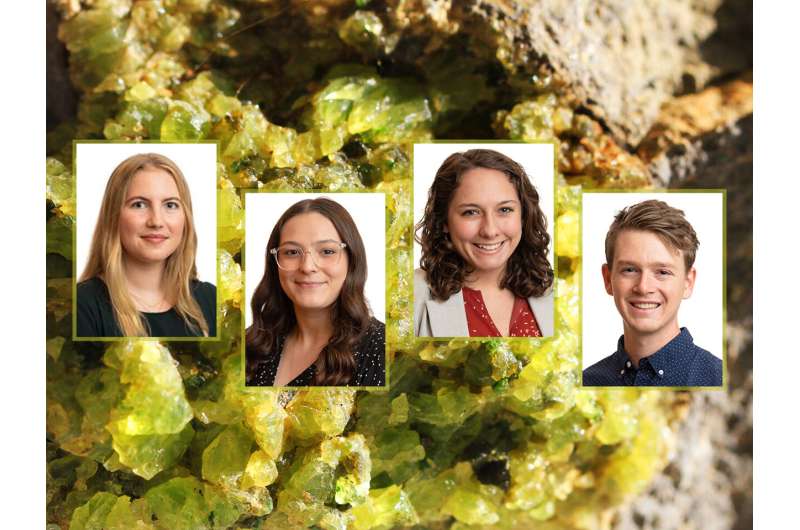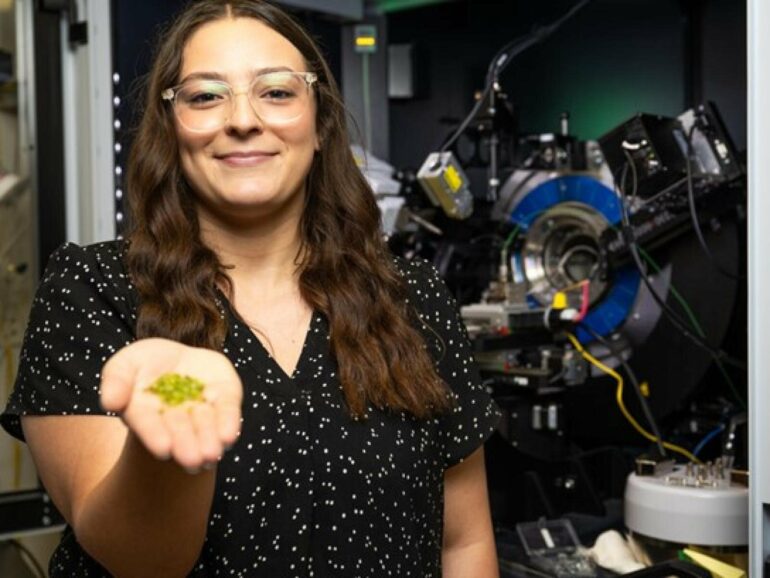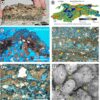Minerals underground may be part of the solution to global climate change. The most famous greenhouse gas, carbon dioxide (CO2), can react with some minerals found deep underground to form stable carbonates—permanently storing the CO2. This storage mechanism has helped naturally regulate CO2 throughout Earth’s history.
This conversion process, known as carbon mineralization, has proven challenging to implement on an industrial scale. Making carbon mineralization a viable, practical process requires developing a fundamental understanding of the behavior of promising storage reservoirs and minerals.
Olivine is one of the most abundant minerals on Earth, found in large quantities in the crust and mantle. The structure of olivine can incorporate critical materials such as nickel and cobalt. If these critical materials are released during carbon mineralization and can be recovered, this would create an additional revenue source for carbon storage projects.
This potential for critical mineral recovery makes olivine-rich reservoirs an interesting target for CO2 mineralization. But determining which deposits are the most promising requires determining the amounts of critical elements they contain. Identifying the exact composition of olivine in these reservoirs can involve significant labor-intensive labwork, adding complexity to the exploration of new resources.
A team of researchers and interns at Pacific Northwest National Laboratory (PNNL) developed an expanded database that will allow scientists to connect the analysis of olivine’s structure to its composition. Instead of requiring complicated measurements, researchers can leverage the relationship between X-ray diffraction data and chemical composition to quickly learn more about an olivine sample.
The research article, published in ACS Earth and Space Chemistry, also resulted in a journal cover.
“Representing the relationship between olivine structure and composition is essential for taking the next steps in exploring the reactivity of olivine for carbon mineralization and critical mineral recovery,” said Quin Miller, a PNNL chemist and co-corresponding author of the paper. “We’re also making it easier for more people to determine the composition of olivine.”

The interns who contributed to the olivine-focused research, from left to right—Madeline Bartels, Arianna Morfin, Madeline Murchland, and Heath Stanfield. © Shannon Colson | Pacific Northwest National Laboratory
Interns take center stage
The project was a collaboration between PNNL staff and interns from three different Department of Energy programs, including two from the Office of Science Workforce Development for Teachers and Scientists (WDTS).
The interns—Arianna Morfin, Heath Stanfield, Madeline Murchland, and Madeline Bartels—were part of the WDTS Community College Internships, WDTS Science Undergraduate Laboratory Internships, and Mickey Leland Energy Fellowship programs.
“It’s rewarding on a professional level to help jump-start the careers of these young scientists,” said Subsurface Energy Systems Subsector Manager Todd Schaef, a co-author of the paper. “But their contributions really make this whole thing work. Without them, we wouldn’t have been able to create such a useful tool that can be applied all over the world.”
Despite the short time most of the interns spent at PNNL, as little as 10 weeks, their contributions were significant. “This was truly an intern-lead paper,” said Miller. “The data compilation, analysis, figure making, and manuscript writing was all done by these early career scientists. Beyond edits and advising during the writing process, I was able to let them take the lead in directing the paper.”
The team pulled together structure and composition data from previously published papers and an existing international database. The interns had to scour existing databases, identify outliers or duplicates, and update chemistries based on what was reported in the literature. After collecting the data, the team worked to develop structure–composition equations for common types of olivine with different chemical compositions.
“Previous studies used 60 or fewer data points to look at the structure–composition relationships of olivine,” said Stanfield, now a post-bachelor’s research associate and co-corresponding author on the paper.
“While they were helpful, they focused more on standard compositions and didn’t look at the effects of common elemental substitutions. For practical matters, understanding these minor changes in composition is essential since they can have a big effect. It took lots of digging, but we found and used almost triple that amount of unique data points.”
Discover the latest in science, tech, and space with over 100,000 subscribers who rely on Phys.org for daily insights.
Sign up for our free newsletter and get updates on breakthroughs,
innovations, and research that matter—daily or weekly.
The importance of olivine to carbon sequestration and critical mineral recovery
Importantly, the database includes information about olivine compositions between the end case, full compositions. This makes the team’s structure–composition relationship equations more accurate for the complicated reality of the naturally occurring minerals central to some carbon storage efforts.
The structure of olivine means that the mineral contains one or more metals incorporated into its structure. This multifaceted structure means that researchers must fully characterize each different olivine-based site. One site may have more magnesium, while another has more nickel-bearing olivine. The specific composition can have a major effect on whether a site is practical for carbon sequestration and critical mineral recovery.
“From a realistic standpoint, all olivine can’t be treated as the same,” said Stanfield. “We’re giving people effective tools to make identifying exactly what they’re working with faster and easier.”
This work is being actively used in the development of an exploration vector for identifying U.S. resources with the highest potential for both carbon mineralization and recovery of critical minerals like nickel, cobalt, and copper. It can assist in the site selection process by informing researchers about the number of cations available to form carbonates and the quantity of critical minerals that can be recovered.
This manuscript was a particularly good candidate for team science and getting input from all the interns. Bartels also worked to develop a technique to count mineralized carbon with higher sensitivity than standard processes.
Stanfield was part of a team that created a methodology for estimating the carbon storage and critical mineral extraction potential in basalt.
All the interns are continuing to work in scientific fields. Morfin is currently enrolled in a surgical technology program at Yakima Valley College. Bartels and Murchland are both continuing to Ph.D.s in geological sciences at the University of Calgary and Colorado School of Mines, respectively. Both also have plans to return to PNNL to conduct further research. Stanfield remains at PNNL as a post-bachelor’s research associate, with plans to start his Ph.D. in the fall of 2025.
“The effects of carbon dioxide emissions are an ever-increasing problem we need to solve,” said Miller. “Seeing the next generation of scientists work to meet these challenges is incredible.”
More information:
Arianna M. Morfin et al, Structure–Composition Relationships for Mg–Ni and Mg–Fe Olivine, ACS Earth and Space Chemistry (2024). DOI: 10.1021/acsearthspacechem.4c00044
Provided by
Pacific Northwest National Laboratory
Citation:
Enhanced dataset connects composition and structure of a complex mineral for carbon storage (2025, January 8)



